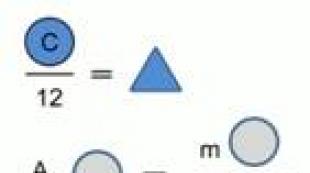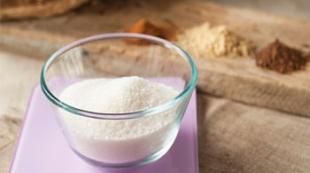What does relative atomic molecular mass show? How to calculate atomic mass
The masses of atoms and molecules are very small, so it is convenient to choose the mass of one of the atoms as a unit of measurement and express the masses of the remaining atoms relative to it. This is exactly what the founder of atomic theory, Dalton, did, who compiled a table of atomic masses, taking the mass of the hydrogen atom as one.
Until 1961, in physics, 1/16 of the mass of the oxygen atom 16 O was taken as an atomic mass unit (amu), and in chemistry - 1/16 of the average atomic mass of natural oxygen, which is a mixture of three isotopes. The chemical unit of mass was 0.03% larger than the physical one.
Currently, a unified measurement system has been adopted in physics and chemistry. The standard unit of atomic mass is 1/12 of the mass of a 12 C carbon atom.
1 amu = 1/12 m(12 C) = 1.66057×10 -27 kg = 1.66057×10 -24 g.
DEFINITION
Relative atomic mass of an element (A r) is a dimensionless quantity equal to the ratio of the average mass of an atom of an element to 1/12 of the mass of an atom of 12 C.
When calculating relative atomic mass, the abundance of isotopes of elements in the earth's crust is taken into account. For example, chlorine has two isotopes 35 Cl (75.5%) and 37 Cl (24.5%). The relative atomic mass of chlorine is:
A r (Cl) = (0.755×m(35 Cl) + 0.245×m(37 Cl)) / (1/12×m(12 C) = 35.5.
From the definition of relative atomic mass it follows that the average absolute mass of an atom is equal to the relative atomic mass multiplied by amu:
m(Cl) = 35.5 × 1.66057 × 10 -24 = 5.89 × 10 -23 g.
Examples of problem solving
EXAMPLE 1
| Exercise | In which of the following substances the mass fraction of the oxygen element is greater: a) in zinc oxide (ZnO); b) in magnesium oxide (MgO)? |
| Solution |
Let's find the molecular weight of zinc oxide: Mr (ZnO) = Ar(Zn) + Ar(O); Mr (ZnO) = 65+ 16 = 81. It is known that M = Mr, which means M(ZnO) = 81 g/mol. Then the mass fraction of oxygen in zinc oxide will be equal to: ω (O) = Ar (O) / M (ZnO) × 100%; ω(O) = 16 / 81 × 100% = 19.75%. Let's find the molecular weight of magnesium oxide: Mr (MgO) = Ar(Mg) + Ar(O); Mr (MgO) = 24+ 16 = 40. It is known that M = Mr, which means M(MgO) = 60 g/mol. Then the mass fraction of oxygen in magnesium oxide will be equal to: ω (O) = Ar (O) / M (MgO) × 100%; ω(O) = 16 / 40 × 100% = 40%. Thus, the mass fraction of oxygen is greater in magnesium oxide, since 40 > 19.75. |
| Answer | The mass fraction of oxygen is greater in magnesium oxide. |
EXAMPLE 2
| Exercise | In which of the following compounds is the mass fraction of metal greater: a) in aluminum oxide (Al 2 O 3); b) in iron oxide (Fe 2 O 3)? |
| Solution | The mass fraction of element X in a molecule of the composition NX is calculated using the following formula: ω (X) = n × Ar (X) / M (HX) × 100%. Let's calculate the mass fraction of each element of oxygen in each of the proposed compounds (we will round off the values of relative atomic masses taken from D.I. Mendeleev's Periodic Table to whole numbers). Let's find the molecular weight of aluminum oxide: Mr (Al 2 O 3) = 2×Ar(Al) + 3×Ar(O); Mr (Al 2 O 3) = 2×27 + 3×16 = 54 + 48 = 102. It is known that M = Mr, which means M(Al 2 O 3) = 102 g/mol. Then the mass fraction of aluminum in the oxide will be equal to: ω (Al) = 2×Ar(Al) / M (Al 2 O 3) × 100%; ω(Al) = 2×27 / 102 × 100% = 54 / 102 × 100% = 52.94%. Let's find the molecular weight of iron (III) oxide: Mr (Fe 2 O 3) = 2×Ar(Fe) + 3×Ar(O); Mr (Fe 2 O 3) = 2×56+ 3×16 = 112 + 48 = 160. It is known that M = Mr, which means M(Fe 2 O 3) = 160 g/mol. Then the mass fraction of iron in the oxide will be equal to: ω (O) = 3×Ar (O) / M (Fe 2 O 3) × 100%; ω(O) = 3×16 / 160×100% = 48 / 160×100% = 30%. Thus, the mass fraction of the metal is greater in aluminum oxide, since 52.94 > 30. |
| Answer | The mass fraction of metal is greater in aluminum oxide. |
From the lesson materials you will learn that the atoms of some chemical elements differ from the atoms of other chemical elements in mass. The teacher will tell you how chemists measured the mass of atoms that are so small that you cannot see them even with an electron microscope.
Topic: Initial chemical ideas
Lesson: Relative Atomic Mass of Chemical Elements
At the beginning of the 19th century. (150 years after the work of Robert Boyle), the English scientist John Dalton proposed a method for determining the mass of atoms of chemical elements. Let's consider the essence of this method.
Dalton proposed a model according to which a molecule of a complex substance contains only one atom of different chemical elements. For example, he believed that a water molecule consists of 1 hydrogen atom and 1 oxygen atom. According to Dalton, simple substances also contain only one atom of a chemical element. Those. an oxygen molecule must consist of one oxygen atom.
And then, knowing the mass fractions of elements in a substance, it is easy to determine how many times the mass of an atom of one element differs from the mass of an atom of another element. Thus, Dalton believed that the mass fraction of an element in a substance is determined by the mass of its atom.
It is known that the mass fraction of magnesium in magnesium oxide is 60%, and the mass fraction of oxygen is 40%. Following the path of Dalton's reasoning, we can say that the mass of a magnesium atom is 1.5 times greater than the mass of an oxygen atom (60/40 = 1.5):
The scientist noticed that the mass of the hydrogen atom is the smallest, because There is no complex substance in which the mass fraction of hydrogen would be greater than the mass fraction of another element. Therefore, he proposed to compare the masses of atoms of elements with the mass of a hydrogen atom. And in this way he calculated the first values of the relative (relative to the hydrogen atom) atomic masses of chemical elements.
The atomic mass of hydrogen was taken as unity. And the value of the relative mass of sulfur turned out to be 17. But all the values obtained were either approximate or incorrect, because the experimental technique of that time was far from perfect and Dalton’s assumption about the composition of the substance was incorrect.
In 1807 - 1817 Swedish chemist Jons Jakob Berzelius conducted extensive research to clarify the relative atomic masses of elements. He managed to obtain results close to modern ones.
Much later than the work of Berzelius, the masses of atoms of chemical elements began to be compared with 1/12 of the mass of a carbon atom (Fig. 2).

Rice. 1. Model for calculating the relative atomic mass of a chemical element
The relative atomic mass of a chemical element shows how many times the mass of an atom of a chemical element is greater than 1/12 the mass of a carbon atom.
Relative atomic mass is denoted by A r; it has no units of measurement, since it shows the ratio of the masses of atoms.
For example: A r (S) = 32, i.e. a sulfur atom is 32 times heavier than 1/12 the mass of a carbon atom.
The absolute mass of 1/12 of a carbon atom is a reference unit, the value of which is calculated with high accuracy and is 1.66 * 10 -24 g or 1.66 * 10 -27 kg. This reference mass is called atomic mass unit (a.e.m.).
There is no need to memorize the values of the relative atomic masses of chemical elements; they are given in any textbook or reference book on chemistry, as well as in the periodic table of D.I. Mendeleev.
When calculating, the values of relative atomic masses are usually rounded to whole numbers.
The exception is the relative atomic mass of chlorine - for chlorine a value of 35.5 is used.
1. Collection of problems and exercises in chemistry: 8th grade: to the textbook by P.A. Orzhekovsky and others. “Chemistry, 8th grade” / P.A. Orzhekovsky, N.A. Titov, F.F. Hegel. – M.: AST: Astrel, 2006.
2. Ushakova O.V. Chemistry workbook: 8th grade: to the textbook by P.A. Orzhekovsky and others. “Chemistry. 8th grade” / O.V. Ushakova, P.I. Bespalov, P.A. Orzhekovsky; under. ed. prof. P.A. Orzhekovsky - M.: AST: Astrel: Profizdat, 2006. (p. 24-25)
3. Chemistry: 8th grade: textbook. for general education institutions / P.A. Orzhekovsky, L.M. Meshcheryakova, L.S. Pontak. M.: AST: Astrel, 2005.(§10)
4. Chemistry: inorg. chemistry: textbook. for 8th grade. general education institutions / G.E. Rudzitis, Fyu Feldman. – M.: Education, OJSC “Moscow Textbooks”, 2009. (§§8,9)
5. Encyclopedia for children. Volume 17. Chemistry / Chapter. ed.V.A. Volodin, Ved. scientific ed. I. Leenson. – M.: Avanta+, 2003.
Additional web resources
1. Unified collection of digital educational resources ().
2. Electronic version of the journal “Chemistry and Life” ().
Homework
p.24-25 No. 1-7 from the Workbook in Chemistry: 8th grade: to the textbook by P.A. Orzhekovsky and others. “Chemistry. 8th grade” / O.V. Ushakova, P.I. Bespalov, P.A. Orzhekovsky; under. ed. prof. P.A. Orzhekovsky - M.: AST: Astrel: Profizdat, 2006.
>> Mass of an atom. Relative atomic mass
Atomic mass. Relative atomic mass
The material in this paragraph will help you figure out:
> what is the difference between atomic mass and relative atomic mass ;
> why is it convenient to use relative atomic masses;
> where to find the relative atomic mass of an element.
This is interesting
The mass of an electron is approximately 9 10 -28 g.
Atomic mass.
An important characteristic of an atom is its mass. Almost all the mass of an atom is concentrated in the nucleus. Electrons have such a small mass that they are usually neglected.
compared with 1/12 - the mass of a Carbon atom (it is almost 12 times heavier than a Hydrogen atom). This small mass was called the atomic mass unit (abbreviated as a.m.u.):
1 a. e.m. = 1/12m a (C) = 1/12 1.994 10 -23 g = 1.662 10 -24 g.
The mass of the Hydrogen atom almost coincides with the atomic mass unit: m a (H) ~ 1a. e.m. The mass of the Uranium atom is greater than it in
That is
m a (U) ~ 238 a. eat.
The number obtained by dividing the mass of an atom of an element by the atomic mass unit is called the relative atomic mass of the element. This value is denoted by A r (E):

The index next to the letter A is the first letter in the Latin word relativus - relative.
The relative atomic mass of an element shows how many times the mass of an atom element more than 1/12 the mass of a carbon atom.
m a (N) = 1.673 10 -2 4 g
m a (H)= 1 a. eat.
A r (H) = 1
The relative atomic mass of an element has no dimension.
The first table of relative atomic masses was compiled almost 200 years ago by the English scientist J. Dalton.
Based on the material presented, the following conclusions can be drawn:
Relative atomic masses are proportional to the masses of the atoms;
the ratios of atomic masses are the same as the relative atomic masses.
The relative atomic masses of chemical elements are written in periodic table.
John Dalton (1766- 1844)

Outstanding English physicist and chemist. Member of the Royal Society of London (English Academy of Sciences). He was the first to put forward a hypothesis about the different masses and sizes of atoms, determined the relative atomic masses of many elements and compiled the first table of their values (1803). He proposed symbols for elements and designations for chemical compounds.
Having made over 200,000 meteorological observations, having studied the composition and properties of air, he discovered the laws of partial pressures gases(1801), thermal expansion of gases (1802), solubility of gases in liquids (1803).

Rice. 35. Cell of the element Uranus
They are determined with very high accuracy; the corresponding numbers are mostly five and six digits (Fig. 35).
In ordinary chemical calculations, relative atomic masses are usually rounded to whole numbers. So, for Hydrogen and Uranus
A r (H) = 1.0079 ~ 1;
A r (U) = 238.029 ~ 238.
Only the relative atomic mass of Chlorine is rounded to the nearest tenth:
A r (Cl) = 35.453 ~ 35.5.
Find the relative atomic masses of Lithium, Carbon, Oxygen, Neon in the periodic table and round them to whole numbers.
How many times are the masses of the atoms of Carbon, Oxygen, Neon and Magnesium greater than the mass of the Helium atom? For calculations, use rounded values of relative atomic masses.
note: elements are arranged in the periodic table in order of increasing atomic masses.
conclusions
Atoms have extremely low mass.
For convenience of calculations, relative masses of atoms are used.
The relative atomic mass of an element is the ratio of the mass of an atom of the element to the mass of a carbon atom.
The values of relative atomic masses are indicated in the periodic table of chemical elements.
?
48. What is the difference between the concepts “atomic mass” and relative atomic mass?”
49. What is an atomic mass unit?
50. What do the entries A r and A r mean?
51. Which atom is lighter - Carbon or Titan? How many times?
52. Which has more mass: a Fluor atom or two Lithium atoms; two atoms of Magnesium or three atoms of Sulfur?
53. Find in the periodic table three or four pairs of elements whose atomic mass ratio is: a) 1: 2; b) 1:3.
54. Calculate the relative atomic mass of Helium if the mass of an atom of this element is 6.647 - 10 -24 g.
55. Calculate the mass of a Beryllium atom.
Popel P. P., Kryklya L. S., Chemistry: Pidruch. for 7th grade. zagalnosvit. navch. closing - K.: VC "Academy", 2008. - 136 p.: ill.
Lesson content lesson notes and supporting frame lesson presentation interactive technologies accelerator teaching methods Practice tests, testing online tasks and exercises homework workshops and trainings questions for class discussions Illustrations video and audio materials photographs, pictures, graphs, tables, diagrams, comics, parables, sayings, crosswords, anecdotes, jokes, quotes Add-ons abstracts cheat sheets tips for the curious articles (MAN) literature basic and additional dictionary of terms Improving textbooks and lessons correcting errors in the textbook, replacing outdated knowledge with new ones Only for teachers calendar plans training programs methodological recommendationsAbsolute masses of atoms One of the fundamental properties of atoms is their mass. Absolute (true) mass of an atom– the value is extremely small. It is impossible to weigh atoms on a balance because such precise scales do not exist. Their masses were determined using calculations. For example, the mass of one hydrogen atom is 0.000 000 000 000 000 000 000 001 663 grams! The mass of a uranium atom, one of the heaviest atoms, is approximately 0.000 000 000 000 000 000 000 4 grams. Writing and reading these numbers is not easy; You can make a mistake by missing a zero or adding an extra one. There is another way to write it - in the form of a product: 4 ∙ 10−22 (22 is the number of zeros in the previous number). The exact mass of the uranium atom is 3.952 ∙ 10−22 g, and the hydrogen atom, the lightest among all atoms, is 1.673 ∙ 10−24 g. It is inconvenient to carry out calculations with small numbers. Therefore, instead of the absolute masses of atoms, their relative masses are used.
Relative atomic mass
The mass of any atom can be judged by comparing it with the mass of another atom (find the ratio of their masses). Since the determination of the relative atomic masses of elements, various atoms have been used as comparisons. At one time, hydrogen and oxygen atoms were unique standards for comparison. A unified scale of relative atomic masses and a new unit of atomic mass, adopted International Congress of Physicists (1960) and unified by the International Congress of Chemists (1961). To this day, the standard for comparison is 1/12 of the mass of a carbon atom. This value is called the atomic mass unit, abbreviated a.u.m. Atomic mass unit (amu) – mass of 1/12 of a carbon atom Let's compare how many times the absolute mass of a hydrogen and uranium atom differs from 1 amu, to do this we divide these numbers by one another: The values obtained in the calculations are the relative atomic masses of the elements - relative 1/12 the mass of a carbon atom. Thus, the relative atomic mass of hydrogen is approximately 1, and that of uranium is 238. Please note that relative atomic mass does not have units of measurement, since the units of absolute mass (grams) are canceled out when dividing. The relative atomic masses of all elements are indicated in the Periodic Table of Chemical Elements by D.I. Mendeleev. The symbol used to indicate relative atomic mass is Аr (the letter r is an abbreviation for the word relative, which means relative). The relative atomic masses of elements are used in many calculations. As a rule, values given in the Periodic Table are rounded to whole numbers. Note that the elements in the Periodic Table are arranged in order of increasing relative atomic masses. For example, using the Periodic Table we determine the relative atomic masses of a number of elements:Ar(O) = 16; Ar(Na) = 23; Ar(P) = 31. The relative atomic mass of chlorine is usually written as 35.5! Ar(Cl) = 35.5
- Relative atomic masses are proportional to the absolute masses of atoms
- The standard for determining relative atomic mass is 1/12 of the mass of a carbon atom
- 1 amu = 1.662 ∙ 10−24 g
- Relative atomic mass is denoted by Ar
- For calculations, the values of relative atomic masses are rounded to whole numbers, with the exception of chlorine, for which Ar = 35.5
- Relative atomic mass has no units of measurement









